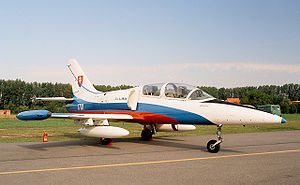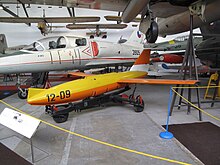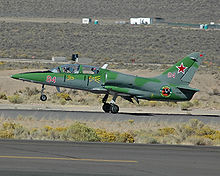Aero L-39
| Aero L-39 "Albatros" | |
|---|---|
 L-39 Albatross |
|
| Type: | Training aircraft |
| Design country: | |
| Manufacturer: | |
| First flight: |
4th November 1968 |
| Commissioning: |
1971 |
| Production time: |
1968-1999 |
| Number of pieces: |
<3000 |

The Aero L-39 Albatros is a two-seat , single - engine trainer aircraft that was developed in Czechoslovakia as the successor to the L-29 Delfín and is still used by the air forces in several countries.
history
In 1963, work began on a successor to the L-29. Initially, the responsible chief designer Jan Vlček and the production manager of the aero plant Karel Dlouhy considered a modernized “Dolphin” variant with the project designation L-129, which, however, would not have met all requirements. The development group therefore turned to a completely new design with the project name TTP . A first model study was carried out in 1964, and a few more followed the following year, including one on a scale of 1: 5, which was mainly used for wind tunnel tests. A 1: 1 front fuselage section with cockpit was then built for studies of the instrument arrangement. A 1: 1 model of the entire aircraft was also created. In 1967 a state control commission approved the continuation of the development program. In parallel with the project, work began on the VS-1BRI ejection seat, the NKTL-29-39 ejection seat simulator, the TL-39 flight simulator and the KL-39 mobile control system.
The first flight was carried out on November 4, 1968, chief pilot Rudolf Duchon with the second prototype X-02 (OK-32) from the aero factory airfield, because X-01 was used exclusively for stress tests on the ground. In December, the third prototype was completed and included in testing. With the two machines, the first reject tests with the newly developed ejection seat were also carried out in July 1971. The X-04 was built exclusively for material fatigue tests, which were carried out from the beginning of 1970 to October 1971 at the Vysočany Aviation Institute (VZLÚ). With the fifth prototype, which flew for the first time on September 23, 1969, suitability tests for military use were carried out from February 1, 1971 by the Research Center Prague-Kbely.
On April 28, 1970, the sixth prototype X-06 with the improved Ivchenko AI-25TL engine took off for its maiden flight. It was used to carry out shooting and dropping exercises from external loads and the mobile control station KL-39 was tested. X-07 finally flew for the first time on December 15, 1970. It had all the changes made during the test and was extensively tested by the Soviet Air Force from May 1973. It served as the initial sample of the first production version L-39C , which was delivered from the beginning of 1974 and had two external load carriers for a maximum of 500 kilograms.
At the end of 1972, testing of the X-08 began, which served as the starting model for the single-seat target tow version L-39V . Instead of the rear seat, the L-39V had a tow drum. The 1700 meter long tow rope was extended with the help of a dynamic pressure turbine attached under the hull. The towing target KT-04 was specially developed for this purpose . It was 4.9 meters long, had a wingspan of 5.3 meters and weighed 110 kilograms. Normally the L-39V flew at a maximum speed of 600 km / h and a towing altitude of 500 to 2500 meters. The LSK the NVA continued (tactical numbers from 1982 two L-39V 170 and 171 a).
The prototypes X-09, X-10 and X-11, built from 1973 to 1976, served as starting samples for the weapons trainer L-39ZO and the light ground combat and reconnaissance aircraft L-39ZA and completed their trials in 1977. The L-39ZO had a reinforced structure and four external load stations (load capacity outside 250, inside 500 kilograms), where bombs of up to 500 kilograms, UB-16-57 cassette containers for 16 unguided S-5 air-to-surface missiles each , Additional fuel tanks with 150 liters (outside) or 350 liters (inside), guided air-to-air missiles or machine gun containers 7.62 or 12.7 millimeters can be carried. When used as a reconnaissance aircraft , the L-39ZO usually flew with a camera container on the left inner carrier and a 350-liter additional container on the right.
The L-39ZA had a reinforced landing gear compared to the ZO and, in addition to the four external girders, could be equipped with a 23 mm GSch-23 cannon in a gondola under the fuselage. The ammunition supply of 150 rounds was under the rear pilot's seat.
A twelfth prototype was created, which was used for long-term material fatigue studies.
Since the start of series production , the aircraft has become the standard trainer for the Warsaw Pact air forces , with the exception of Poland . The largest holder was the former Soviet Union; other users were or are, among others, Afghanistan, Egypt, Bangladesh, Bulgaria, Iraq, Cuba, Libya, Romania, Syria, Thailand , Czechoslovakia and Vietnam. Also in the NVA of the German Democratic Republic , 54 L-39s were in service with the FAG-25 (Fliegerausbildungsgeschwader) and the ZDK-33 (target display chain) from 1977 to 1990.
A total of almost 3000 pieces of this aircraft were built.
In July 2014, Aero Vodochody in Farnborough announced that it was working on a further development of the L-39. The L-39NG (for New Generation ) is equipped with the FJ44-4M engine, which gives it higher speed and greater range with lower fuel consumption. The wings got a new shape and the cockpit got more modern equipment. The first flight took place on September 14, 2015, and series production is scheduled to begin in 2018. The public presentation of the first copy with the number 7001 took place on October 12, 2018 . The first customer with an order for four L-39NG is Senegal. A second prototype first flew on December 9, 2019.
variants

- L-39C - C as in Cvičná or Training, basic jet trainer, of which over 2660 pieces were built
- L-39CM - modernized C variant of the Slovak Air Force
- L-39M1 - modernized C variant of the Ukrainian Air Force
- L-39V - V for Vlečná or target tug, pulled the tow target KT-04
- L-39ZO - Z like Zbraně or weapons, weapon deployment trainer
- L-39ZA - like ZO, but with a GScha-23L cannon container and K-13 guided weapons
- L-39MS - Super Albatros, a prototype later than L-59 was produced
- L-39ZA / ART - Thai variant
- L-39NG - prototype of a modernized version FJ44-4M -Triebwerk
Military users
- 5 × L-39C
![]() Afghanistan - Afghan Air Force
Afghanistan - Afghan Air Force
- 2 × L-39C
- 7 × L-39C
- 32 × L-39ZA
- 6 × L-39C
- 40 × L-39IN
![]() Equatorial Guinea - Equatorial Guinean Air Force
Equatorial Guinea - Equatorial Guinean Air Force
- 2 × L-39C
![]() Azerbaijan - Azerbaijani Air Force
Azerbaijan - Azerbaijani Air Force
- 28 × L-39C
![]() Ethiopia - Ethiopian Air Force
Ethiopia - Ethiopian Air Force
- 17 × L-39C
![]() Bangladesh - Bangladeshi Air Force
Bangladesh - Bangladeshi Air Force
- 8 × L-39ZA
![]() Bulgaria - Bulgarian Air Force
Bulgaria - Bulgarian Air Force
- 12 × L-39ZA
![]() German Democratic Republic - Air Force of the National People's Army
German Democratic Republic - Air Force of the National People's Army
- 52 × L-39IN
- 2 × L-39V
- 2 × L-39C (leased from KS Avia)
- 2 × L-39IN
- 22 × L-39C
- 59 × L-39IN
- 12 x L-39C
![]() Cambodia - Cambodian Air Force
Cambodia - Cambodian Air Force
- 8 × L-39ZA
- 4 × L-39C
- 30 × L-39C
- 0 × L-39ZO of 181 procured
![]() Lithuania - Lithuanian Air Force
Lithuania - Lithuanian Air Force
- 1 × L-39ZA (acquired a total of 2 L-39ZA from the Czech Republic and 4 L-39C from Kyrgyzstan)
- 24 × L-39ZA
![]() North Korea - North Korean Air Force
North Korea - North Korean Air Force
- 12 x L-39C
- 0 × L-39ZA of 32 procured
- 1000 x L-39C
- 4 × L-39ZAM
- 4 × L-39CM
- 70 × L-39ZA (2012)
- 11 × L-39IN
![]() Czech Republic - Vzdušné síly AČR
Czech Republic - Vzdušné síly AČR
- 7 × L-39C
- 9 × L-39ZA
![]() Czechoslovakia - Czechoslovak Air Force - before division (passed on to subsequent states)
Czechoslovakia - Czechoslovak Air Force - before division (passed on to subsequent states)
- 33 × L-39C
- 6 × L-39MS
- 8 × L-39V
- 30 × L-39ZA
- 40 × L-39ZA / ART
![]() Turkmenistan - Turkmen Air Force
Turkmenistan - Turkmen Air Force
- 2 × L-39
![]() Uganda - Ugandan Air Force - 1 crashed in northern
Uganda
Uganda - Ugandan Air Force - 1 crashed in northern
Uganda
- 3 × L-39ZA
- 39 × L-39M1
- 20 × L-39IN
![]() Vietnam - Vietnamese Air Force
Vietnam - Vietnamese Air Force
- 12 x L-39C
![]() Belarus - Belarusian Air Force
Belarus - Belarusian Air Force
- 10 × L-39C
L-39s that are registered for civilian use also fly. First-time customers for upgrading existing models to the NG version are, for example, the companies LOM in Prague (it flies on a training assignment for the Czech Air Force), Draken International (for the Black Diamond Jet Team, an aerobatic team) and Breitling (for the Breitling Jet Team , too an aerobatic team).
Incidents
The Air Force of the National People's Army lost two L-39s in crashes. Both were in service with the FAG-25 in Bautzen . The first occurred on July 4, 1988 near Pasewalk . A student pilot overlaid during a firing exercise at ground targets at low altitude his plane (factory number 83 in 1117, tactical number 172), causing it to stall came. The pilot catapulted himself too late and was killed. On June 12, 1989, there was another loss of an L-39ZO with the tactical number 156(serial number 73 1019, commissioned November 28, 1977), which crashed near Anklam after an engine failure due to a clogged oil filter . The two-man crew flew the machine away from the inhabited area and therefore catapulted itself too late and was killed.
An L-39ZA acquired by the Lithuanian Air Force in 1998 crashed on August 30, 2011 after a collision with a French Dassault Mirage 2000 . Both inmates survived.
On September 1, 2012, a restored L-39 (N139GS) ran out of control at an air show near Mount Joy , Iowa, and exploded on impact on the ground. The 59-year-old pilot was killed in the accident.
On September 11, 2014, a Ugandan Air Force L-39 crashed near Gulu in northern Uganda . The pilot was able to get to safety with the ejection seat. Technical problems are suspected to be the cause.
On December 6, 2015, an L-39 crashed shortly after take-off at Apple Valley Airport in California / USA. One passenger and the pilot Mike Mangold , a former Red Bull Air Race pilot , were killed.
On March 3, 2020, a Syrian L-39 was shot down by a Turkish F-16 over Idlib, according to Turkish information.
technology
construction
The goal of high reliability and easy maintainability was achieved through an uncomplicated construction. This includes the fuselage in half-shell construction made of metal (except for the nose cone), whose rear fuselage section with the associated tail units is attached to the central main assembly with only five bolts. Thus, for example, a quick dismantling for the engine change is guaranteed. The one-piece wings are each attached at four points to the lower part of the fuselage and have a moderate positive V-position of 2.5 °. The rudder, ailerons and elevators are controlled by mechanical linkages. The aircraft was equipped with several safety mechanisms for the exercise: The air brakes extend automatically at Mach 0.8, the landing gear was designed for hard landings and is equipped with an anti-lock braking system.
Armament
- Gun loading from 284 (C variant) to 1,500 kg (ZA / ZO variants) at two to four external load stations
- adaptable armament under the front fuselage
- 1 × fuselage gondola with a 23-mm automatic cannon Grjasew-Schipunow GSch-23 L (9А472) with 150 rounds of ammunition (only variant ZA)
- Air-to-air guided missile (only variant ZA)
- 2 × BD3-60-21U starting rails for 1 × Wympel R-3S / R-13M (AA-2 "Atoll") each - infrared-guided, self-targeting for short distances
- Unguided air-to-surface missiles
- 2–4 × UB-16-57UMP missile tubular launch container with 16 unguided air-to-surface missiles of the type S-5 in caliber 57 mm
- Unguided bombs
- 2–4 × Basalt FAB-100 (100 kg free-fall bomb )
- 2–4 × basalt OFAB-100 (100 kg free-fall bomb)
- 2–4 × Basalt FAB-250 (250 kg free-fall bomb)
- 2 × Basalt FAB-500 (500 kg free fall bomb)
- External container
- 2 × GUW-9-A-669 universal containers for one 23 mm twin cannon GSch-233 L with 250 rounds of ammunition
- 2 × SzPPU-22 cannon container with a 23 mm machine cannon GSch-23L with a vertical movement of 30 ° and 260 rounds of ammunition
- 2 × additional fuel tanks for 350 liters of kerosene
- 2 × drop-off additional tanks for 150 liters of kerosene
- 1 × camera case
- 1 × towed air target KT-04 (only L-39V)
Technical specifications
| Parameter | Data (L-39C) |
|---|---|
| crew | 1-2 |
| length | 12.13 m |
| span | 9.46 m with outer tanks |
| height | 4.77 m |
| Wing area | 18.80 m² |
| Empty mass | 3565 kg |
| Max. Takeoff mass | 4700 kg |
| Engine | an Ivchenko Progress AI-25 -TL engine |
| thrust | 16.87 kN (1720 kp) |
| Top speed | 700 km / h near the ground 750 km / h at 5000 m altitude |
| Initial rate of climb | 22 m / s |
| Range | 840 km |
| Summit height | 11,500 m |
| Takeoff route | 480 m |
| g limit | + 8 / −4 |
There are also versions equipped with more powerful engines and additional tanks, the L-39ZA and L-59 with ranges of 2500 kilometers, speeds of up to 870 km / h and summits of up to 12,200 meters.
Others
At the National Air Race Championships in Reno , Nevada, races in the jet class have been flown with the L-39 since 2002.
The Breitling Jet Team uses the L-39 for their aerobatic demonstrations. The Russian aerobatic team Vyazma Rus also flies with up to nine L-39 formations, mainly in the CIS region .
Especially in the USA, an L-39C with a red and yellow flame design is regularly shown at air shows. Solo demonstrations are flown with the machine (registration number NX39LW, called "Firecat-Jet").
The opening sequence of the James Bond film Tomorrow Never Dies from 1997 shows the appearance of two L-39s. One of the aircraft, marked in the film with the registration number 28 08, is a former L-39ZO of the Fliegerausbildungsgeschwader 25 of the NVA and was stationed in Bautzen from 1977 to 1990 (registration number 140 , works number 731002).
See also
literature
- Rainer Göpfert: L-39 Albatros jet trainer . The most built coach in the east. PPVMedien, Bergkirchen 2016, ISBN 978-3-95512-136-5 .
- Detlef Billig, Manfred Meyer: Airplanes of the GDR. Type book military and civil aviation. III. Volume until 1990 . TOM Modellbau, Friedland 2003, ISBN 3-613-02285-0 .
- Wilfried Copenhagen : Airplanes and helicopters of the NVA from 1971 to the present . Edition f. int. economy, 1991, ISBN 3-327-00768-3 .
- Peter Alles-Fernandez (Ed.): Aircraft from A to Z. Volume I: Aamsa Quail - Consolidated P2Y . Bernard & Graefe, Koblenz 1987, ISBN 3-7637-5904-2 .
- Wilfried Copenhagen: The other albatrosses . In: Fliegerrevue . No. 5 , 1984.
- Olaf Reich: Aero L-39 . In: Fliegerrevue . No. 2 , 1977.
Web links
- Website about the L-39 aircraft
- Luftfahrttechnischer Museumsverein Rothenburg eV : Rothenburg belonged to the fighter pilot training squadron of the LSK / LV of the GDR
- Aero L-39 Albatross. www.globalsecurity.org, accessed March 4, 2020 .
Individual evidence
- ↑ New L-39NG flies for the first time . In: Fliegerrevue . No. 11/2015 , p. 8 .
- ^ R. S .: Albatros has offspring . In: Fliegerrevue . No. 09/2014 , p. 39 .
- ↑ Georg Mader: Aero Vodochody presents the new Czech jet trainer L-39NG. Next generation of the albatross . In: Fliegerrevue . No. 01/2019 , p. 24-26 .
- ↑ Flieger Revue No. 02/2020, p. 8
- ↑ World Air Forces 2011/2012. (PDF; 3.3 MB) Flightglobal Insight, 2012, p. 25 , accessed on July 25, 2018 (English).
- ^ Paris Air Show 2015: Aero Vodochody announces three L-39NG launch customers, Janes, June 16, 2015
- ^ Detlef Billig, Manfred Meyer: Airplanes of the GDR . Type book military and civil aviation. III. Volume until 1990. TOM Modellbau, Friedland 2003, ISBN 3-613-02285-0 , p. 175 .
- ↑ Rainer Langener: My years on the ejection seat . Helios, Aachen 2014, p. 227-229 .
- ↑ Lithuanian Air Force plans to buy L-39s , message on airheadsfly.com from April 18, 2014, accessed on June 25, 2014 (English)
- ^ Preliminary NTSB report on the crash at an air show at Mt. Joy accessed on September 10, 2012
- ^ Report of New Vision (Uganda) : accessed on September 11, 2014
- ↑ Famous Red Bull Pilot Killed in Apple Valley Plane Crash. www.vvng.com, December 6, 2015, accessed on March 4, 2020 .
- ↑ Idlib: Syrian military plane shot down by Turkish forces. de.sputniknews.com, March 3, 2020, accessed March 4, 2020 .

